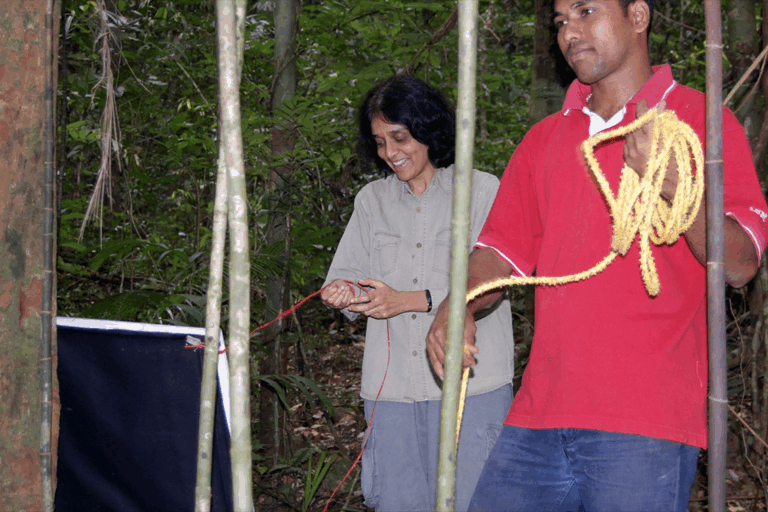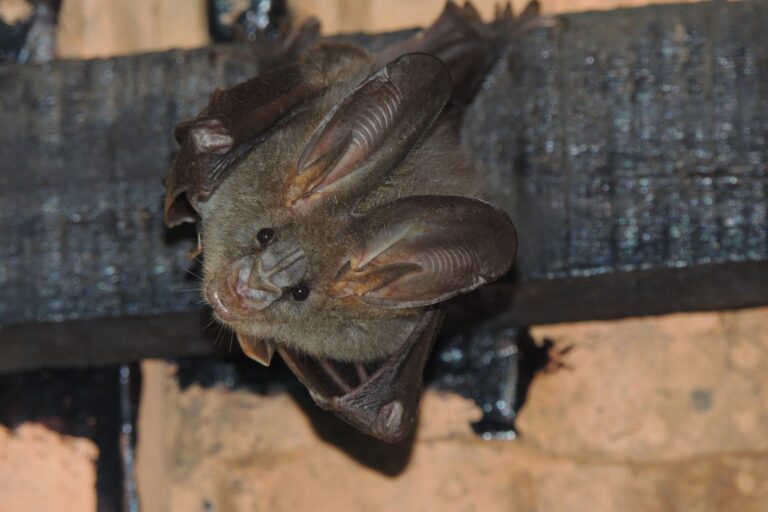
- Rohini Balakrishnan has spent decades listening to insects, uncovering what their calls reveal about behaviour, communication, and evolution.
- In this interview with Mongabay India,
she highlights the potential of combining audio archives, machine learning, and citizen science to bridge critical knowledge gaps in the acoustic data for insects. - As acoustic monitoring gains ground globally, she reflects on what’s missing in India and why insect sounds deserve more than being dismissed as background noise.
Insects may be small, but their acoustic worlds are vast and complex. Rohini Balakrishnan has spent her career listening in. A professor at the Indian Institute of Science in Bengaluru, she leads the Animal Communication and Bioacoustics Lab.
From campus labs to field sites on the city’s outskirts and deep in the evergreen forests of Karnataka’s Western Ghats, Balakrishnan and her team study the causes and consequences of animal behaviour by focusing on their calls. These sounds offer a window into insect evolution, communication, and ecosystem change.
In this conversation with Mongabay India, Balakrishnan reflects on what insect calls can reveal about species and their habitats, the challenges of studying such a diverse group in India, and the tools that may help overcome them. As acoustic monitoring gains traction globally, she highlights both its potential and its pitfalls. She explains why insect calls are far more than just “noise”.

Mongabay: What are some insights you’ve learned about insects just by listening to them?
Rohini Balakrishnan (RB): Systematics and species delineation usually rely on visuals: museum specimens, photos, etc. But many insects, especially nocturnal ones like crickets, are visually cryptic. They look identical, yet are actually different species and have unique acoustic signals. When you shift from the visual to the acoustic domain, distinct species become evident.
Listening has always driven my research. Every question began by walking and listening. You hear this huge range of sound frequencies and wonder: who’s producing what? How are animals managing to communicate in such a noisy environment, say, to a female of their own species when everyone is calling at the same time?
We started tracking calls, who’s calling, when and where, over 15 years. We even built a 3D acoustic model of a rainforest. What sounds like cacophony to us often dissolves into silence when measured along the right axes. Either animals have solved the problem of interference, or maybe the problem never existed the way we thought.
Mongabay: Your work on bat and insect relationship also proved some assumptions wrong. Can you tell us about the work and what you found?
RB: That started with listening too. In Kudremukh, I was trying to track a calling insect in the dark. I turned off my torch since I find it distracting when I’m trying to localise sound with my ears. Something brushed past my face. I turned on the red light and saw a bat catching a calling insect.
It sparked a question: these crickets are making loud, broadband calls, why hasn’t there been evolutionary selection against that, especially in the genus Mecopoda (bush crickets)? In the neotropics, studies showed that bat predation may have led to shorter or vibrational calls in crickets. But we weren’t seeing that in India.
So we asked: How likely are bats to approach and capture these calling crickets?
First, we identified the predator, the lesser false vampire bat, by finding cricket wings under bat roosts in abandoned houses. We’ve studied it for years and found counterintuitive results. Males (crickets) call and females are silent, So you would assume that males are at high risk, because they’re the ones producing loud calls. But females were eaten more often!
In enclosure experiments, we tested how often bats approached calls, flying insects, and walking ones. We found calling and flying individuals are approached equally, so they’re at equal risk.

Mongabay: Tracking small, nocturnal insects in dense forests sounds tiring. How do you do that?
RB: Most of this work is done by my students, though I’ve done it too. There’s no substitute for the human brain in localising sound. You isolate a call, figure out its direction and height, and approach slowly. Once you locate the insect, you record the call, catch it, mark it with a non-toxic paint code, and release it. These species are solitary and don’t stay in one place, so we spend a week marking every calling individual in a patch. Then we return to track calls, using red light so we don’t disturb them. If the insect stays, we briefly use white light to read the code. We’re among the few who’ve done this kind of manual tracking on solitary insects.

Mongabay: Why is it important to monitor insects at a landscape level?
RB: Insects are powerful indicators of land use and ecosystem health because they’re small and highly sensitive to microhabitat and microclimate. But they’ve not received enough attention in eco-acoustic studies.
Mongabay: Can you elaborate on that?
RB: Restoration studies often focus on vegetation or birds. But insects are always present in soundscapes and call across a wide frequency range, from below one kilohertz to ultrasound.
It’s telling that eco-acoustics papers often refer to insect sounds as “noise.” The field is so vertebrate-focused that insects get overlooked.
You can compute various acoustic indices from spectrograms, images that show sound frequencies over time, from audio recordings. But their usefulness is mixed, especially when ground-truthed; for example, if we ask how the mathematical result correlates with the known number of vocalising species on the ground. And most of that work has been on birds, not insects.

Mongabay: What limits the use of insect acoustics in biodiversity monitoring?
RB: You can use recorders to collect soundscapes and create spectrograms. The visual patterns or sonotypes reflect different acoustic signals you hear in the habitat. But to count species, you need a one-to-one match between each acoustic pattern and species identity, like we have for birds. That’s easier in Europe or North America with fewer species and more research. In India, we’re far from that.
For insects, there’s a taxonomic hurdle and we lack fundamental acoustic data. Original taxonomic specimens are often in European museums. But acoustic species often look identical, so even 3D images of museum specimens aren’t enough. You still need to see the animal, make a recording, and know exactly who it is. We did this for about 25-30 species in Kudremukh, but how do you do that for 30,000?
Recorders are cheap now, so we’re collecting massive data. In passive acoustic monitoring, you put out a bunch of recorders and collect sounds. We need repositories to store and reuse this data. What you extract depends on your question.
It’s also a big data problem. Machine learning can help, but you need to know what problem you’re solving and feed the system the right information about what the sounds are to get anything useful.
Mongabay: Is there a way to link insect identities to sounds more efficiently?
RB: We need a citizen science movement. Everyone has a mobile phone, and while the audio may not be high-quality, it’s usable. If people uploaded images, sounds, and GPS locations, like on iNaturalist, we could build that data. The key is linking a confirmed image to a sound and location. Someone still has to ground-truth it, but it’s a great start. In a country like India, with limited funding prioritising documentation, this may be the only scalable solution. Species communities can change every 50-100 km in India. Identifying and linking species to sound is a gargantuan task.
We can also use museum specimens and machine learning. Using finite element models (FEM), we predicted the carrier frequencies of nine cricket species accurately. Alternatively, one could focus on soundscapes. Instead of identifying every species, analyse frequency bands or sonotypes as indicators of habitat quality. One of my PhD students is doing this using soundscapes as proxies for ecological health.

Mongabay: What do we know about insects in urban environments?
RB: I’m a bit sceptical of the literature on anthropogenic noise and insects. Most studies are correlational, like comparing insects near roads and farther away, and show differences in calls or behaviour. But many other factors could be at play.
Some lab experiments play traffic noise to insects. Yes, calling behaviour changes as noise increases. But unlike birds, insects don’t exhibit the Lombard effect–they don’t get louder in noise. They might stop calling, and females may struggle to find mates.
But I don’t think lab setups reflect real-world urban cricket experiences. I’ve spent years reconstructing acoustic perceptual environments, and we need realistic and manipulative field experiments to study the impact of anthropogenic noise on insects. Also, insects don’t hear well below one kilohertz. So low-frequency traffic noise, which affects birds, might not affect insects the same way. Vibrations might matter more. But traffic noise also has high-frequency components, which can overlap with insect calls.
It’s a fascinating subject. I probably won’t pursue this further in my academic career, but I hope someone will take it forward with a different, more field-based methodology.
Mongabay: What is the future of insect bioacoustics in India?
RB: Eco-acoustic monitoring is a major opportunity. It’s relatively cheap, scalable, and can help track landscape changes. Countries like Norway, the UK, and Australia already run national acoustic monitoring networks.
It can help in agriculture too. Most pests don’t make loud airborne sounds, but they do produce vibrations, like larvae feeding inside stems. These can be detected with sensors. There’s already promising work in this area.
Mongabay: After three decades of work, does it still surprise you how little we know about insects?
RB: I’ve stopped being surprised. Everything I’ve studied has led to new findings or shown that our simple assumptions don’t hold. That’s exciting because it means there’s much more going on.
Listen to the Wild Frequencies Podcast:


Banner image: A bat catches a bush cricket. Image by Saravanakumar.




































































































































































































































































































































































































































































































































